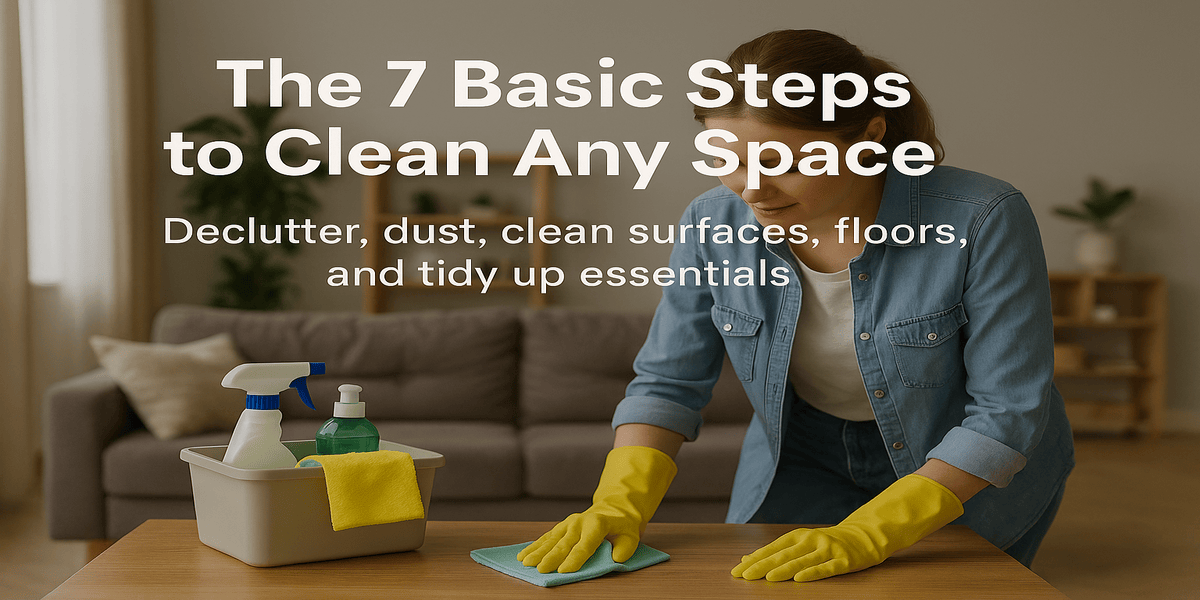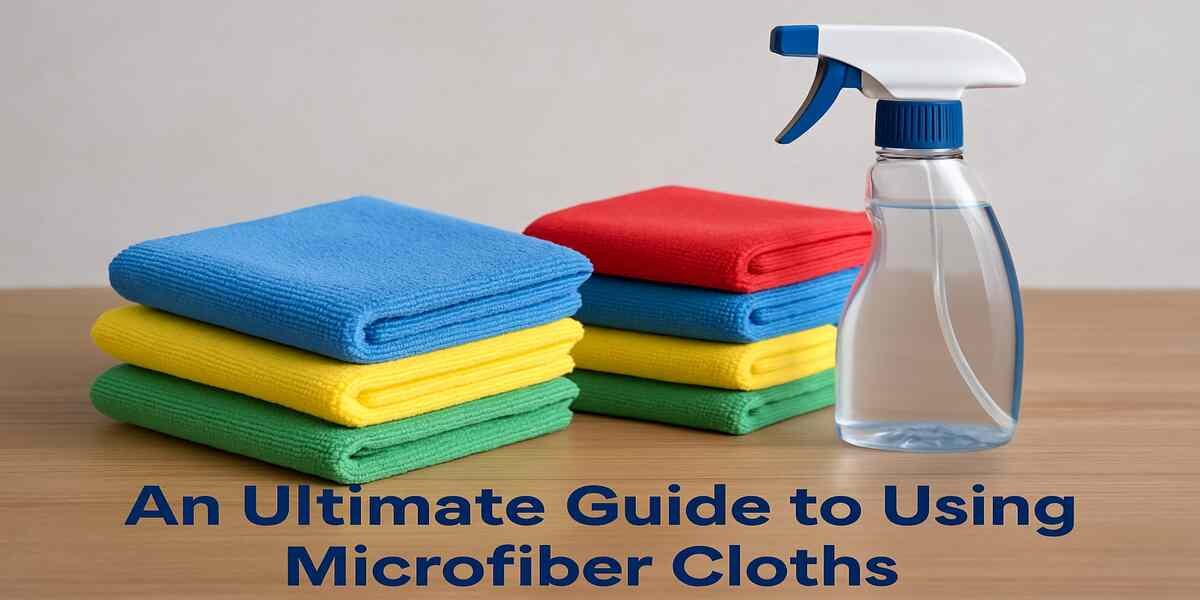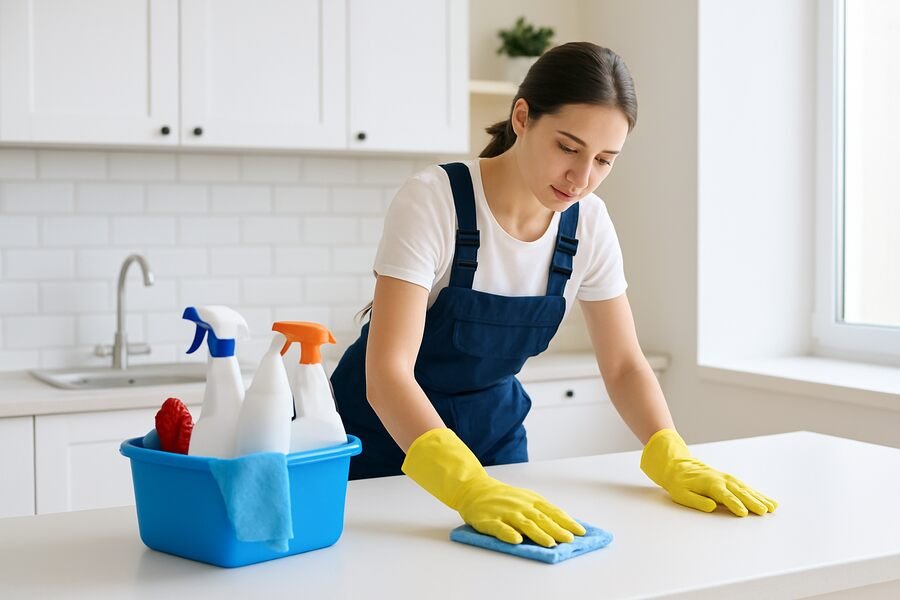What Are The 7 Basic Steps To Clean Any Space?

How to Clean Any Space in 7 Easy Steps
Wish you could clean up your places without thinking it through as something tedious? Have you ever been in the middle of a cluttered room and everything comes to a screeching stop because you marvel at the messiness of it all? Perhaps it is the cleaning up of one desk, followed by a run to the kitchen, then a failure to complete with the entire kitchen cleaned and then out to the bathroom-and hours have passed with nothing thoroughly cleaned. Sound familiar? The fact is that cleaning is not always complicated and worn out. In the bedroom, office, and yes, even your home, there is a plain and easy way to organise. It only demands a methodical plan to spice up any area so that it can appear clean, new and brilliant. Therefore, here are the 7 simple steps that will de-clutter any area with a clear conscience.
1. De-scrub Dishes: Tidy Up Everything
To begin with, items that are utterly out of place require treatment, according to Bond Cleaning Southport. Following a procedure does not make any sense when objects are scattered all around. Should shoes be lying in the sitting room while dishes find their way to the bedroom and some random papers are scattered across the kitchen counter, those items go straight into a box or a basket for sorting later. Every single item must be categorised: Keep (stay), Relocate (go elsewhere), or Toss (throw away). This sets a precedent to some degree for what visual appeal is gained. Besides, it points out surfaces that need thorough cleaning.
2. Wiping and Surface Cleaning
Attention can now be directed towards surface cleaning and wiping away leftover clutter, enabling the sharpening of surface cleaning. Don’t forget to wipe ceiling fans and light construction fixtures as well as furniture tops, shelves, storage surfaces, and tables. The proper order of top to bottom should always be kept to check tasks off. To keep hygiene standards, appropriate modest scrub with duster and cloth bits needs to be maintained with a microfiber washable duster, while traditional cloth wash rags are not allowed. For best practices, you can also check the Australian guidelines on environmental cleaning. Wooden, glass and plastic surfaces need only the tiniest amount of moisture left after cleaning, but in the case of any other material, a mud cloth will suffice, provided that it is used together with the proper cleaning product.
3. Organise Soft Furnishings and Upholstered Fabric
Include amongst soft furnishings cushions and rugs, curtains, and upholstered furniture. Such furnishings should be vacuumed with a special nozzle, brushed, and cushions should be fluffed. Loose rugs need shaking and vacuuming. In bedrooms, remove dirty linens and soiled bedding, wash, and make the bed. These activities reduce harmful particles, and through these processes, a soft and clean, comfortable space is enhanced.
4. Hard Floors and Carpeted Areas
Floors must also be involved in other activities of cleaning. In the case of tiles on the floor, sweepers as well as mops come in handy. Areas with rugs and carpeted spaces will require prolonged and limited vacuuming to clean the hair and dust. Hard floor like bathroom tiles, vinyl and wooden planks need mops and appropriate detergents. Corners and spaces behind furniture left by most people are some of the common hotspots where the dust would be. The hygiene and the look of the floors are greatly affected by the floors as they shift in status between grimy and prohibited to glistening clean.
5. Set up Order the Basics
After undertaking the detailed cleaning task, you should also ensure that you arrange everything that can be organised in the space. It means the shelves should have books ordered, the stationery put away in drawers, toiletries organised in baskets, and kitchen items placed in cabinets. For cleaning tools, the storage boxes, trays, and dividers can be used to categorise them for easy retrieval. It makes the space look neater and saves time when looking for items. Organised spaces are the most important declutter management approach as they optimise the clean-up process entirely.
6. Make Extra Adjustments
When all the space is arranged in the category of organised, the completion touches should be given to it, which makes the space more inviting. To do that, the room should be aired (windows should be opened) as a candle is burnt, or an oil diffuser or fabric freshener is applied. Light in a room, the position of pillows and minor plant features or decorations with lights are helpful too. This makes you go and spend time in the space, therefore, the effort of actually building the space.
7. Maintain the Clean with Daily Mini-Cleans
This part of the text outlines the steps to take within the days immediately following your area’s care. Spending five minutes a day on brief cleans over the next few days will contribute toward a noticeable change. Should you wish to make use of my help in bed making, wiping surfaces, or picking up trash during pre-sleep hours, do reach out to me. Regularly scheduled vacuuming or laundry mid-week also helps. These efforts will make a difference in how much deep cleaning will need to be done. For sure, your area will remain clean for longer stretches of time, living up to the expectation that the work required will blend seamlessly into the rhythmic flow of life.
Conclusion
There is no doubt that work like this does not have to feel overwhelming or too frantic. If the 7 steps: declutter, dust, soft wash surfaces, clean floors, essentials tidy, proper order for essentials, final details, and daily maintenance are followed, any work required will be pleasantly manageable.
Thus, if you want to reset a workspace, refresh a living room, or prepare for guests, you can calmly return to centre with this technique. A cluttered space isn’t a problem that requires extensive effort to solve. You can simply follow the steps provided, take one deep breath, and enjoy the peaceful and effortlessly ordered space of your room.



